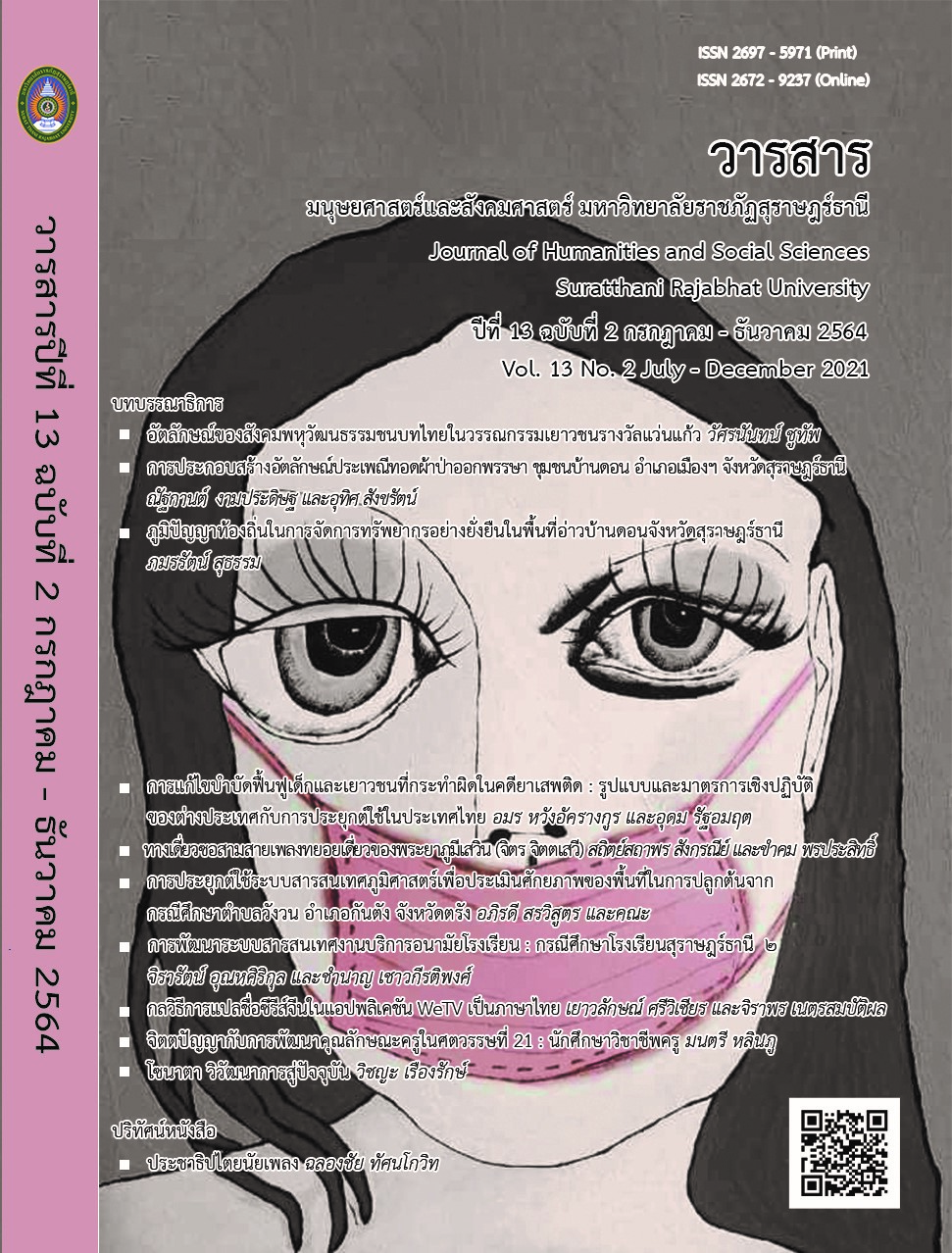Rehabilitating Juvenile Offenders in Drug Cases : International Models and Practical Measures for Proposing Applications to Thailand
Main Article Content
Abstract
This research article aims to study models and practical measures in foreign countries for rehabilitating juvenile offenders in drug cases,including those in accordance with the United Nations Office on Drugs and Crime (UNODC), United States, and European Union (EU) regulations.
Qualitative research was done by systematic content analysis of documents to synthesize models and practical measures best suited for rehabilitating juvenile offenders in drug cases to apply them to juvenile justice administration in Thailand. Results showed that the following characteristics were mostinfluential: rehabilitation must follow the best interest of the child on a basis of multiservice packages for case management. Rehabilitation programs may be adjusted according to the individual issues or needs of each juvenileoffender. A medical model is used for drug use harm reduction therapy in conjunction with rehabilitation and aftercare treatment for families and in community-based programs. These best practices should be adopted by the juvenile justice system in Thailand following provisions of the Administration of Juvenile Offenders Rehabilitation Act, B.E.2561 (2018) to allow juveniles full protection of their rights, welfare, and a secure future.
Article Details

This work is licensed under a Creative Commons Attribution-NonCommercial-NoDerivatives 4.0 International License.
All published manuscripts have been verified by peer-peer professors in the fields of humanities and social sciences. Reprinting of the article must be authorized by the editorial staff.
References
ฉัตรสุมน พฤฒิภิญโญ. (2559). การทบทวนและสังเคราะห์องค์ความรู้กฎหมายยาเสพติด
เปรียบเทียบ : รูปแบบกฎหมายและแนวทางการควบคุมยาเสพติด. รายงานการ วิจัยแผนงานภาคีวิชาการสารเสพติด. กรุงเทพฯ: สำนักงานกองทุนสนับสนุน
การสร้างเสริมสุขภาพ.
อัคคกร ไชยพงษ์. (2555). การพัฒนากลยุทธ์การป้องกันและแก้ไขปัญหาการกระทำผิดซ้ำ
ของผู้ต้องขังชายในเรือนจำ เขต 8. วารสารมนุษยศาสตร์และสังคมศาสตร์
มหาวิทยาลัยราชภัฏสุราษฎร์ธานี. (4)1, 125-148.
Altschuler, D.M. (2008). Rehabilitating and Reintegrating Youth Offenders :
Are Residential and Community Aftercare Colliding Worlds and
What Can Be Done About It?. Justice Policy Journal. The Center on
Juvenile and Criminal Justice.
Anja Busse, et al. (2020). UNODC Family-based Treatment Training Package
(UNFT) for adolescents with drug and other substance use disorders
including those in contact or at risk of contact with the criminal
justice system. [Online]. Retrieved from https://www.unodc.org/
documents/1904629_UNFT_Poster_90x140_ebook.pdf. [2020, Au
gust 21].
EURehab Children. (2015). Best Practices Handbook on Rehabilitation of
Juvenile Offenders and Victims. Erasmus+ Programme of European
Union.
Hedden, S.L. et al. (2020). Behavioral Health Trends in the United States :
Results from the 2014 National Survey on Drug Use and Health. U.S.
Department of Health and Human Services, Substance Abuse and
Mental Health Services Administration, Center for Behavioral Health
Statistics and Quality. [Online]. Retrieved from www.samhsa.gov/
data. [2020, August 1].
Lipsey, M.W., Wilson, D.B., and Cothern, L. (2020). Effective Intervention for
Serious Juvenile Offenders. Juvenile Justice Bulletin. Washington
D.C.: Center for Juvenile Justice Reform, Georgetown Public Policy
Institute, Georgetown University.
Lipsey, M.W. (2006). The Effects of Community-Based Group Treatment for
Delinquency: A Meta-Analytic Search for Cross-Study Generalizations.
Deviant : Problem and Solutions Peer Influences in Programs for
Youth. New York: The Guilford Press.
Lipsey, M.W., Cullen F.T. (2007). The Effectiveness of Correctional Rehabilitation : A
Review of Systematic Reviews. The Annual Review of Law and
Social Science. California: Annual Reviews.
Lipsey, M.W. (2009). The Primary Factors that Characterize Effective
Interventions with Juvenile Offenders: A Meta-Analytic Overview.
Victims and Offenders. UK: Routledge Taylor and Francis Group.
Lipsey, M.W. et al. (2010). Improving the Effectiveness of Juvenile Justice
Programs : A New Perspective on Evidence-Based Practice. US:
Office of Juvenile Justice and Delinquency Prevention, U.S.
Department of Justice.
Lynch L. E., Mason K. V., Listenbee R. L. (2016). Juvenile Drug Treatment
Court Guidelines. The Office of Juvenile Justice and Delinquency
Prevention (OJJDP), U.S. Department of Justice.
National Drug Court Resource Center. (2020). Treatment Court Count Map.
[Online]. Retrieved from https://ndcrc.org/wp-content/NDCRC_
Court_Map/. [2020, August 1].
O’Connell, Nestlerode, Miller. (1999). Evaluation of the Delaware Juvenile
Drug Court Diversion Program. The Criminal Justice Council’s
Statistical Analysis Center, Office of Justice Programs, U.S.
Department of Justice.
The United Nations Office on Drugs and Crime. (2014). Guidance for
Community-Based Treatment and Care Services for Drug Users in
Southeast Asia. Bangkok: Regional Office for Southeast Asia and the
Pacific.
The United Nations Office on Drugs and Crime. (2019). UNODC TRAINING
MATERIALS on elements of family therapy for the treatment of
adolescents with drug and other substance use disorders including
adolescents in contact with or at risk of contact with the criminal
justice system. Vienna: Prevention, Treatment and Rehabilitation
Section.
The United Nations Office on Drugs and Crime. (2020). Final Report Treatnet
Family : A Feasibility Study on Training on Elements of Family
Therapy for Adolescents with Substance Use Disorders including
those in Contact with the Criminal Justice System in Jakarta,
Indonesia. Vienna: Prevention, Treatment and Rehabilitation
Section Drug Prevention and Health Branch.
VanderWaal C. J., McBride D. C., Terry-McElrath Y. M., VanBuren H. (2001).
Breaking the Juvenile Drug-Crime Cycle : A Guide for Practitioners
and Policymakers. National Institute of Justice, Office of Justice
Programs, U.S. Departmsent of Justice.


